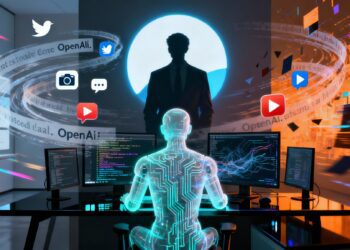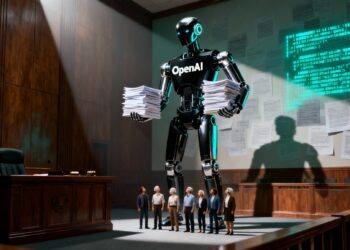The Paradox of Progress and Pain

Microsoft just dropped a bombshell that’s got everyone talking. The tech giant revealed it saved over $500 million using AI tools last year. Sounds impressive, right? Here’s the kicker: this announcement came just days after the company laid off 9,000 employees. Talk about timing.
Chief Commercial Officer Judson Althoff shared these figures during an internal presentation this week. He highlighted how AI tools are boosting productivity across sales, customer service, and software engineering. The call center operations alone saved Microsoft more than $500 million, according to Bloomberg’s reporting.
But here’s what makes this story sting. Those massive savings are being celebrated while thousands of workers are cleaning out their desks. For employees who lost their jobs at a company reporting record profits, Althoff’s remarks might feel tone-deaf.
The Numbers Don’t Lie
Let’s break down what’s really happening at Microsoft. The company has been on a layoff spree throughout 2025. We’re talking about roughly 15,000 jobs cut across three major rounds this year.
Here’s the timeline that tells the story:
- January 2025: Over 2,300 employees were shown the door across LinkedIn, Azure, GitHub, Xbox, and core engineering
- May 2025: Another 6,000 jobs vanished in what Microsoft called “strategic rebalancing”
- June 2025: Around 305 positions were eliminated, mostly at the Redmond headquarters
- July 2, 2025: The biggest hit yet—about 9,000 employees across multiple divisions
Meanwhile, Microsoft just posted $26 billion in profit and $70 billion in revenue for the first quarter. The company’s market cap has surged to around $3.74 trillion, displacing Apple and trailing only Nvidia.
AI: The Silent Workforce Revolution
So what’s really driving these changes? Microsoft isn’t explicitly saying AI is replacing human workers. But the writing’s on the wall.
The company is now using AI extensively for tasks that used to require large teams. Customer interactions, lead generation, and even software development are increasingly handled by AI tools like Microsoft Copilot and ChatGPT integrations.
According to TechCrunch’s reporting, AI now generates 35% of the code for new Microsoft products. That’s accelerating launch times and reducing the need for human developers.
Althoff told employees that each salesperson using Copilot is finding more leads, closing deals quicker, and generating 9% more revenue. The company is also starting to use AI for interactions with smaller customers an effort that’s already generating tens of millions of dollars.
The Human Cost of Efficiency
The layoffs haven’t hit all departments equally. Some areas are getting hammered harder than others.
Xbox and Gaming Studios took a massive hit. Teams behind major titles like Halo, Perfect Dark, and Forza saw significant cuts. Some games were quietly canceled, and many developers were let go.
Sales and Marketing divisions are seeing entire layers eliminated. Microsoft is embracing AI to handle what human sales teams used to do. Even experienced sales leaders and mid-level managers have been shown the door.
Engineering and Product Teams represent over 40% of the layoffs. Software developers, product managers, and technical program managers are being cut as the company automates more work internally.
Middle Management is getting flattened. Microsoft is eliminating several management layers to streamline decision-making. Regional offices in Europe, Australia, and New Zealand have also been hit hard.
The Uncomfortable Truth About Timing
What makes this situation particularly uncomfortable is the timing. Microsoft is celebrating massive AI-driven cost savings while simultaneously cutting thousands of jobs during a period of record profitability.
The situation got even more awkward when Xbox Game Studios producer Matt Turnbull posted on LinkedIn (later deleted) suggesting that workers feeling “overwhelmed” by layoffs might find support through AI tools like ChatGPT and Copilot. The irony wasn’t lost on anyone.
As The Economic Times reported, this has raised serious concerns about AI replacing human jobs, especially when Microsoft is planning to invest $80 billion in AI infrastructure in 2025.
Where the Money’s Really Going

Microsoft has made it clear where its priorities lie. The company announced in January it would invest $80 billion into AI infrastructure across 2025. That’s a massive bet on artificial intelligence.
While Microsoft continues to hire, it’s becoming increasingly selective. The company appears positioned to participate aggressively in the industry-wide competition of “Who Can Pay Top AI Researchers The Most?”
Translation: Microsoft is more likely to spend millions on elite AI talent than retain middle managers and other traditional employees. The focus has shifted from scaling up teams to targeted recruitment of breakthrough AI researchers.
The Ripple Effect Across Tech
Microsoft isn’t alone in this trend. Other tech giants are following similar patterns.
Salesforce has said 30% of internal work at the company is now being handled by AI, allowing it to reduce hiring for some roles. Executives at Alphabet and Meta have noted that significant chunks of code are now being written with AI assistance.
According to PYMNTS reporting, companies like Ford and JPMorgan have also warned of potential deep job cuts as AI continues to advance.
The Ethical Question Nobody’s Asking
Here’s the uncomfortable question at the heart of this story: Should companies celebrate AI savings when thousands of jobs are being lost?
On one hand, AI is undeniably making businesses more efficient and profitable. Microsoft’s $500 million in savings proves that. On the other hand, using AI to cut costs and then immediately laying off thousands of workers can feel cold especially when profits are soaring.
Microsoft’s situation highlights the growing tension between technological advancement and human employment. While AI brings massive gains, companies will need to manage not just their balance sheets, but also public perception of how they treat employees during this AI-driven transformation.
What This Means for Tech Workers
The road ahead looks challenging for many tech workers. While Microsoft is still hiring especially in AI-related roles the shift suggests companies are becoming more selective about human talent.
Positions that don’t directly contribute to AI development or cutting-edge engineering may continue facing pressure. Job security across the tech sector could become more fragile, particularly for those in support, operations, and middle management roles.
The new hiring focus appears less about scaling up teams and more about targeted recruitment of elite AI talent. Workers in traditional roles may need to adapt quickly or risk being left behind.
The Bigger Picture
Microsoft’s story is likely just the beginning. As AI becomes more powerful and cost-effective, similar scenarios will probably play out across the tech industry and beyond.
The company’s $500 million in AI-related savings is a clear sign of how fast automation is changing business operations. But the cost of that progress isn’t just measured in dollars it’s measured in people.
For the 15,000 employees let go this year, those impressive savings numbers might not feel like success. They might feel like loss.
Looking Forward

As AI continues to evolve, stories like Microsoft’s will become more common. The debate over how companies balance profit, people, and progress will only grow louder.
Microsoft’s situation raises fundamental questions about the future of work in an AI-driven world. How do we harness the benefits of artificial intelligence while protecting human livelihoods? How do companies maintain public trust while pursuing technological efficiency?
These aren’t easy questions, and Microsoft’s recent actions suggest the tech industry is still figuring out the answers. What’s clear is that the transformation is happening fast, and the human cost is real.
The $500 million Microsoft saved through AI represents more than just improved efficiency it represents a fundamental shift in how work gets done. Whether that shift ultimately benefits society as a whole remains to be seen.
Sources
- Microsoft shares $500M in AI savings internally days after cutting 9,000 jobs | TechCrunch
- Microsoft Touts $500 Million in AI Savings While Slashing Jobs | LiveMint
- Microsoft cuts jobs amid AI shift | The Economic Times
- Microsoft Lays Off Staff as Savings From AI Top $500 Million | PYMNTS
- Microsoft racks up over $500 million in AI savings while slashing jobs | Reuters









